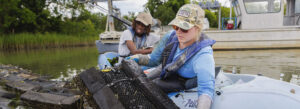Resilience panel says shoot for the moon, think beyond the project, trust the process
When the flooring company Interface produced their first carpet tiles made from reclaimed nylon, they came in only two colors: brown or black. Fast forward to 2020, and that carpeting comes in many more colors—and is made from materials like recycled fishing nets.
“What you’re on now is 100 percent recycled-content nylon,” said Lisa Conway, the vice president for sustainability at Interface. “That has dramatically reduced our company’s negative footprint beyond our four walls.”
Conway shared the company’s journey to net-zero impact during a “Conversation on Collaboration” panel at Hanbury Design focused on resilience and sustainability. Also on the panel were Rhiannon Bezore, the coastal resilience outreach coordinator with Old Dominion University and Virginia Sea Grant, and Maggie Favretti, who leads the education program “DesignEd 4 Resilience” out of Puerto Rico.
The Hampton Roads architects, real estate agents, and other professionals who gathered for the panel are most familiar with terms like “resilience” and “sustainability” in the context of flooding that can affect their daily commutes. Bezore gave an overview of the climate trends responsible for coastal flooding, and what residents can expect to see in the future.
Regionally, the area can expect to see about an average of anywhere from 4.6 to 8 millimeters of sea level rise per year, according to NOAA statistics Bezore shared during the panel. Based on current projections, regional sea level could rise by 4.5 feet in 60-80 years from now. Already, the frequency of nuisance flooding has sharply increased in recent years.
“On a coastal level, we’re going to be expecting rising tides, increased sea level, and increased storm surges,” Bezore said. “We’re expecting increased precipitation, and that will lead to increased surface runoff, so also increased flooding on streets. Pumping the groundwater out… will also make sea level rise impacts much worse.”
Panelists recommended pairing the science with practical suggestions how to make a positive impact. For the design professionals attending the panel, this could mean considering the end-life of the materials they use for their projects.
Bezore also shared different examples of how resilience projects at all levels, like a living shoreline in a homeowner’s backyard, floodable community parks, and Governor Ralph Northam’s executive order to increase the resilience of state-owned buildings.
“On a coastal level, we’re going to be expecting rising tides, increased sea level, and increased storm surges,” Bezore said
Collaboration strengthens resilience projects by adding new perspectives—whether from planners, civic leaders, architects, or students.
During the panel, Favretti shared how the Pueblo Unido Program in Puerto Rico trains the next generation of problem-solvers in design thinking. For example, students designed a resilience-focused community center, rescue strategy, and evacuation map for one of Puerto Rico’s most vulnerable communities.
“Many Puerto Ricans have what I would call a disaster-growth mindset, where they’re thinking about resilience as coming back stronger,” Favretti said. “[It’s thinking] about resilience in such a way that, through collaboration, makes it possible to come back stronger.”
Collaboration strengthens resilience projects by adding new perspectives—whether from planners, civic leaders, architects, or students—as coastal communities prepare for challenges like hurricanes and sunny-day flooding. Panelists emphasized that this collaboration, along with an understanding of resilience and sustainability, requires an open dialogue between different groups—and can be as simple as starting conversations with colleagues or family members.
“It’s an ongoing process that requires effort and attention to how we collaborate,” Favretti said.
Takeaways:
- An educator, sustainability director, and scientist shared how resilience and sustainability applied to their work during a panel at Hanbury Design.
- They discussed how collaboration enriches their work, how to set goals for sustainability, and what climate science means for coastal communities.
- All three panelists shared ways that attendees could contribute to resilience, from starting conversations about climate to considering the end-life of the materials they use for projects.
Photos and video by Aileen Devlin | Virginia Sea Grant
Story by Madeleine Jepsen | Virginia Sea Grant
Published Feb. 15, 2020.
“That has dramatically reduced our company’s negative footprint beyond our four walls,” Conway said.





